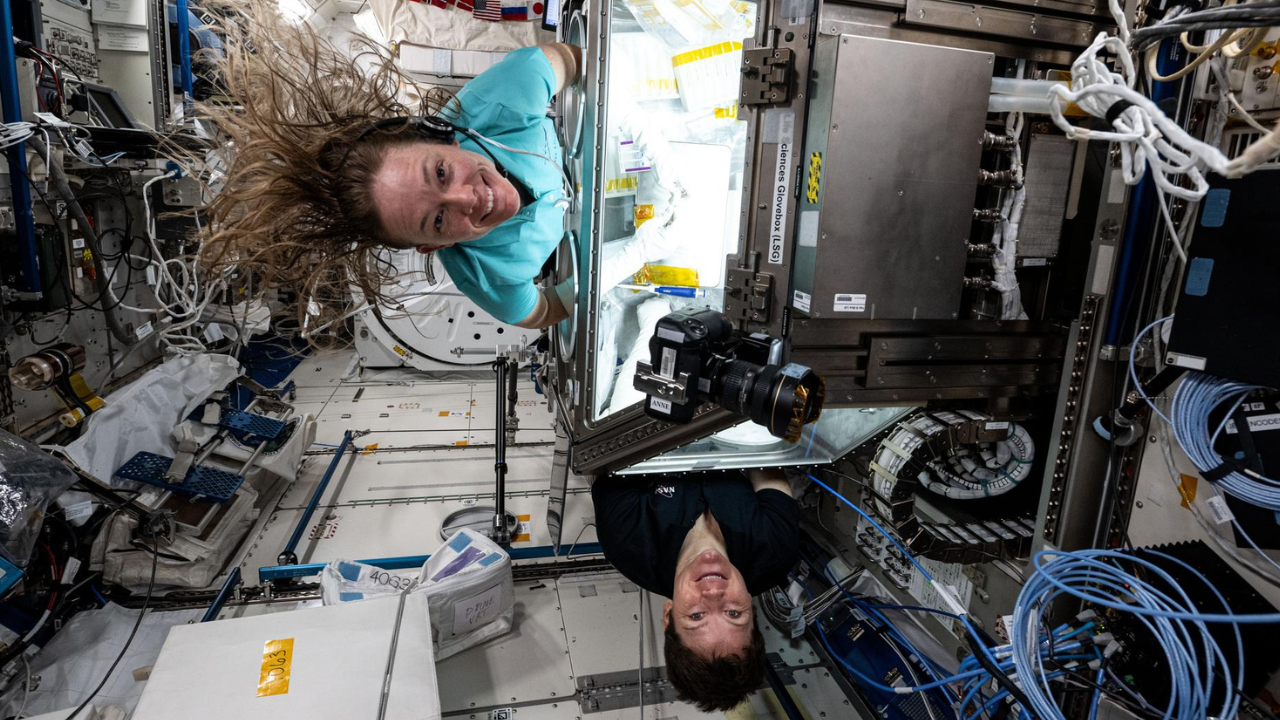NASA’s SpaceX Crew-10 Returns Safely After Completing Dozens of ISS National Lab-Sponsored Investigations

NASA astronauts Anne McClain, top, and Nichole Ayers, right, use the space station’s Microgravity Science Glovebox to work on DNA Nano Therapeutics-Mission 2 from UConn/Eascra Biotech.
Media Credit: NASA
Astronauts wrap up mission after supporting research that could lead to new cancer treatments, more lifelike robotics, space debris removal, and more
August 11, 2025
KENNEDY SPACE CENTER (FL), August 11, 2025 – After nearly six months onboard the International Space Station (ISSInternational Space Station), the four astronauts of NASA’s SpaceX Crew-10 mission have safely returned to Earth. This weekend’s splashdown off the coast of California concludes a long-duration science expedition that supported dozens of investigations sponsored by the ISS National Laboratory®.
NASA astronauts Anne McClain and Nichole Ayers, Japan Aerospace Exploration Agency (JAXA) astronaut Takuya Onishi, and Roscosmos cosmonaut Kirill Peskov played a vital role in advancing science in space, contributing to biomedical research, physical and materials sciences, technology demonstrations, and student-led experiments. Their work helped push the boundaries of discovery in low Earth orbit(Abbreviation: LEO) The orbit around the Earth that extends up to an altitude of 2,000 km (1,200 miles) from Earth’s surface. The International Space Station’s orbit is in LEO, at an altitude of approximately 250 miles. to benefit life on Earth and support a sustainable and robust space economy.
ISS National Lab-sponsored projects the crew worked on during their mission include the following:
- A project from the University of Connecticut and Eascra Biotech, in partnership with Axiom Space, is using microgravityThe condition of perceived weightlessness created when an object is in free fall, for example when an object is in orbital motion. Microgravity alters many observable phenomena within the physical and life sciences, allowing scientists to study things in ways not possible on Earth. The International Space Station provides access to a persistent microgravity environment. to improve the production of Janus base nanomaterials, which could be used to treat diseases like osteoarthritis and cancer. This project builds on previous ISS investigations and is funded through NASA’s In-Space Production Applications(Abbreviation: InSPA) InSPA is an applied research and development program sponsored by NASA and the ISS National Lab aimed at demonstrating space-based manufacturing and production activities by using the unique space environment to develop, test, or mature products and processes that could have an economic impact. program.
- Multiple projects were funded by the U.S. National Science Foundation, which has a long-standing partnership with the ISS National Lab to advance fundamental research on the orbiting laboratory.
- Rensselaer Polytechnic Institute, in partnership with Tec-Masters, is building on previous research to better understand why protein clumping occurs during pharmaceutical manufacturing—a significant challenge in the industry.
- Researchers from the University of California, Santa Barbara, in collaboration with Redwire Space Technologies, are studying a liquid separation phenomenon that could be used to create materials for more lifelike robotics.
- ELVIS may enhance the search for life beyond Earth. Portland State University, in collaboration with NASA’s Jet Propulsion Laboratory in Southern California and Teledyne Brown Engineering, Inc., tested a new holographic microscope—the Extant Life Volumetric Imaging System (ELVIS)—that could allow scientists to study the adaptability of life under extreme conditions.
- Kall Morris Inc, in partnership with Voyager Technologies, leveraged the Astrobee free-flying robots on the space station to validate its REACCH system, which uses tentacle-looking arms with gecko-like adhesive pads to capture floating space debris. REACCH could help protect critical in-orbit infrastructure for Internet communications, weather prediction, GPS, and more.
The ISS National Lab is proud to have partnered with NASANational Aeronautics and Space Administration and international collaborators to enable this impactful space-based research for the benefit of humanity. The return of NASA’s SpaceX Crew-10 mission marks the successful completion of another science expedition in the ongoing effort to leverage space as an innovation platform.
To learn more about the science supported by the astronauts during this mission, visit our launch page.
Download a high-resolution image for this release: Crew-10 Return
Media Contact:
Patrick O’Neill
904-806-0035
PONeill@ISSNationalLab.org
# # #
About the International Space Station (ISS) National Laboratory: The International Space Station (ISS) is a one-of-a-kind laboratory that enables research and technology development not possible on Earth. As a public service enterprise, the ISS National Laboratory® allows researchers to leverage this multiuser facility to improve quality of life on Earth, mature space-based business models, advance science literacy in the future workforce, and expand a sustainable and scalable market in low Earth orbit. Through this orbiting national laboratory, research resources on the ISS are available to support non-NASA science, technology, and education initiatives from U.S. government agencies, academic institutions, and the private sector. The Center for the Advancement of Science in Space® (CASIS®) manages the ISS National Lab, under Cooperative AgreementA cooperative agreement is Federal assistance that establishes a relationship between the U.S. Government and a recipient in which the principal purpose of the relationship is to accomplish a public purpose of support or stimulation. Since 2011, the Center for the Advancement of Science in Space™ (CASIS™) has managed the National Laboratory® through a Cooperative Agreement with NASA. with NASA, facilitating access to its permanent microgravity research environment, a powerful vantage point in low Earth orbit, and the extreme and varied conditions of space. To learn more about the ISS National Lab, visit our website.
As a 501(c)(3) nonprofit organization, CASIS(Abbreviation: CASIS™) The nonprofit organization that manages the ISS National Lab, which receives at least 50 percent of the U.S. research allocation on the International Space Station to facilitate research that benefits humanity (NASA manages the other 50% and focuses on research for space exploration purposes). accepts corporate and individual donations to help advance science in space for the benefit of humanity. For more information, visit our donations page.